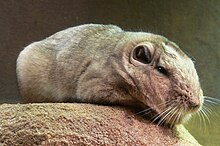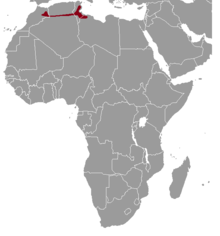38:
211:
89:
64:
653:
365:
A gundi reaches sexual maturity at the age of nine to twelve months. The gestation period is estimated to be 57 days and the litter size averages just under two. Gundis are born with open eyes and fur. They are able to control their body temperature from birth, and are weaned after only four weeks.
369:
The gundi is a territorial species, with family groups of between three and eleven adults defending a territory. Gundis live in colonies, and within these colonies, gundis live in separate units. A unit can be a female, male, and their offspring, or multiple females with juveniles. Gundis sleep in
358:
In the early morning, gundis sunbathe until the temperature passes 20°C (68°F). Once it's hot enough, the gundis will forage and eat, then go back to sunbathing on warm rocks. They will shelter in the shade once the temperature reaches 32°C (90°F). Only after the temperature drops again, in the
359:
afternoon, do gundis leave their shelter. It forages for leaves, stems, flowers and seeds over large distances because of the scarcity of suitable plants. It does not drink, obtaining sufficient water from its diet, nor does it store food as do some desert rodents.
418:
The common gundi is a fairly common species with a wide range, and no particular threats have been identified. Its abundance varies according to the amount of precipitation that falls; in the west of its range it is replaced by
318:
The common gundi grows to a length of between 16 and 20 cm (6.3 and 7.9 in), having a stumpy tail of 10 to 20 mm (0.4 to 0.8 in). A gundi weighs about 185 g (6.5 oz). It resembles a
323:
in appearance, having big eyes, flat ears and short limbs. Each foot has four digits and sharp, dark claws; the two hind feet have comblike bristles between the claws. Gundi's teeth are rootless.
974:
428:
1039:
685:
1116:
948:
987:
633:
523:
339:
at altitudes up to about 2,900 m (9,500 ft). Its range extends from western Libya through
Tunisia and Algeria to eastern Morocco.
1126:
678:
607:
1131:
1013:
1031:
992:
657:
671:
88:
1026:
355:. It lives in rocky, arid places, making its home in crevices and under boulders. These homes are usually temporary.
505:
1044:
362:
Gundis make chirp-like sounds to communicate with each other. If alarmed, they thump their hind feet as well.
900:
399:
1121:
862:
1078:
432:
183:
831:
822:
37:
935:
909:
663:
53:
384:
228:
83:
1083:
482:
210:
979:
1065:
922:
629:
603:
599:
529:
519:
407:
302:
623:
513:
1093:
1070:
914:
477:
390:
200:
561:
1052:
1005:
846:
336:
307:
281:
762:
734:
420:
373:
Of the common gundis tested in southeastern
Tunisia, nearly half were found to harbour
1110:
1000:
745:
592:
509:
468:
160:
73:
68:
459:
927:
594:
Asdell's
Patterns of Mammalian Reproduction: A Compendium of Species-specific Data
1018:
961:
894:
785:
776:
885:
808:
799:
375:
348:
320:
19:
This article is about the North
African gundi. For the rodent in general, see
533:
352:
100:
652:
1057:
879:
722:
716:
395:
379:
120:
590:
Virginia
Douglass Hayssen; Ari Van Tienhoven; Ans Van Tienhoven (1993).
953:
403:
297:
293:
285:
966:
728:
710:
277:
140:
130:
110:
856:
695:
332:
289:
150:
20:
515:
Mammal
Species of the World: A Taxonomic and Geographic Reference
940:
860:
667:
518:(3rd ed.). Johns Hopkins University Press. p. 1536.
453:
451:
449:
447:
625:
Leishmaniasis: New
Insights for the Healthcare Professional
335:
is found in northern Africa on the south side of the
310:
and Louis
Manceaux within the tissues of the gundi.
869:
820:
797:
774:
743:
591:
406:, and it is thought that the gundi may act as a
366:The interval between litters is about 70 days.
429:International Union for Conservation of Nature
679:
8:
483:10.2305/IUCN.UK.2008.RLTS.T5792A11701789.en
857:
686:
672:
664:
209:
62:
36:
27:
481:
370:piles to stay warm during the winter.
306:was first described in 1908 in Tunis by
628:. ScholarlyEditions. 2013. p. 17.
443:
431:has assessed it as being a species of "
402:, a skin disease transmitted by female
598:. Cornell University Press. pp.
555:
553:
551:
549:
547:
545:
543:
7:
1117:IUCN Red List least concern species
469:IUCN Red List of Threatened Species
398:parasites are causative agents of
388:was found in five individuals and
14:
651:
87:
1:
1148:
300:. The parasitic organism
18:
1127:Mammals described in 1776
843:
705:
694:Extant species of family
234:
227:
217:
208:
189:
182:
84:Scientific classification
82:
60:
51:
44:
35:
30:
506:"Family Ctenodactylidae"
220:
1132:Mammals of North Africa
400:cutaneous leishmaniasis
560:Leu, Heather. (2000).
512:; Reeder, D.M (eds.).
504:Dieterlen, F. (2005).
458:Aulagnier, S. (2008).
1079:Paleobiology Database
757:(Ctenodactylus gundi)
765:(Ctenodactylus vali)
660:at Wikimedia Commons
570:Animal Diversity Web
476:: e.T5792A11701789.
427:) in dry years. The
915:Ctenodactylus_gundi
901:Ctenodactylus gundi
871:Ctenodactylus gundi
834:(Pectinator spekei)
832:Speke's pectinator
811:(Massoutiera mzabi)
658:Ctenodactylus gundi
564:Ctenodactylus gundi
462:Ctenodactylus gundi
343:Ecology and biology
273:Ctenodactylus gundi
193:Ctenodactylus gundi
54:Conservation status
46:Ctenodactylus gundi
425:Ctenodactylus vali
410:for the pathogen.
385:Leishmania tropica
276:) is a species of
222: distribution
1104:
1103:
1066:Open Tree of Life
863:Taxon identifiers
854:
853:
699:
656:Media related to
635:978-1-4816-5996-3
525:978-0-8018-8221-0
408:natural reservoir
303:Toxoplasma gondii
284:. It is found in
264:
263:
258:
250:
242:
77:
16:Species of rodent
1139:
1097:
1096:
1087:
1086:
1074:
1073:
1061:
1060:
1048:
1047:
1035:
1034:
1022:
1021:
1009:
1008:
996:
995:
983:
982:
970:
969:
957:
956:
944:
943:
931:
930:
918:
917:
905:
904:
903:
890:
889:
888:
858:
697:
696:Ctenodactylidae
688:
681:
674:
665:
655:
640:
639:
620:
614:
613:
597:
587:
581:
580:
578:
576:
557:
538:
537:
501:
495:
494:
492:
490:
485:
455:
391:Leishmania major
256:
248:
240:
223:
221:
213:
195:
92:
91:
71:
66:
65:
40:
28:
1147:
1146:
1142:
1141:
1140:
1138:
1137:
1136:
1107:
1106:
1105:
1100:
1092:
1090:
1082:
1077:
1069:
1064:
1056:
1053:Observation.org
1051:
1043:
1038:
1030:
1025:
1017:
1012:
1004:
999:
991:
986:
978:
973:
965:
960:
952:
947:
939:
934:
926:
921:
913:
908:
899:
898:
893:
884:
883:
878:
865:
855:
850:
839:
816:
793:
770:
739:
701:
692:
648:
643:
636:
622:
621:
617:
610:
589:
588:
584:
574:
572:
559:
558:
541:
526:
503:
502:
498:
488:
486:
457:
456:
445:
441:
416:
345:
337:Atlas Mountains
329:
316:
308:Charles Nicolle
282:Ctenodactylidae
219:
218:
204:
197:
191:
178:
151:Ctenodactylidae
86:
78:
67:
63:
56:
24:
17:
12:
11:
5:
1145:
1143:
1135:
1134:
1129:
1124:
1119:
1109:
1108:
1102:
1101:
1099:
1098:
1088:
1075:
1062:
1049:
1036:
1023:
1010:
997:
984:
971:
958:
945:
932:
919:
906:
891:
875:
873:
867:
866:
861:
852:
851:
844:
841:
840:
838:
837:
828:
826:
818:
817:
815:
814:
805:
803:
795:
794:
792:
791:
782:
780:
772:
771:
769:
768:
760:
751:
749:
741:
740:
738:
737:
735:Hystricomorpha
731:
725:
719:
713:
706:
703:
702:
693:
691:
690:
683:
676:
668:
662:
661:
647:
646:External links
644:
642:
641:
634:
615:
608:
582:
539:
524:
496:
442:
440:
437:
415:
412:
394:in one. These
344:
341:
328:
325:
315:
312:
280:in the family
262:
261:
260:
259:
257:A. Smith, 1834
251:
243:
232:
231:
225:
224:
215:
214:
206:
205:
198:
187:
186:
180:
179:
172:
170:
166:
165:
158:
154:
153:
148:
144:
143:
138:
134:
133:
128:
124:
123:
118:
114:
113:
108:
104:
103:
98:
94:
93:
80:
79:
61:
58:
57:
52:
49:
48:
42:
41:
33:
32:
15:
13:
10:
9:
6:
4:
3:
2:
1144:
1133:
1130:
1128:
1125:
1123:
1122:Ctenodactylus
1120:
1118:
1115:
1114:
1112:
1095:
1089:
1085:
1080:
1076:
1072:
1067:
1063:
1059:
1054:
1050:
1046:
1041:
1037:
1033:
1028:
1024:
1020:
1015:
1011:
1007:
1002:
998:
994:
989:
985:
981:
976:
972:
968:
963:
959:
955:
950:
946:
942:
937:
933:
929:
924:
920:
916:
911:
907:
902:
896:
892:
887:
881:
877:
876:
874:
872:
868:
864:
859:
849:
848:
842:
836:
835:
830:
829:
827:
825:
824:
819:
813:
812:
807:
806:
804:
802:
801:
796:
790:
789:
788:(Felovia vae)
784:
783:
781:
779:
778:
773:
767:
766:
761:
759:
758:
755:Common gundi
753:
752:
750:
748:
747:
746:Ctenodactylus
742:
736:
732:
730:
726:
724:
720:
718:
714:
712:
708:
707:
704:
700:
689:
684:
682:
677:
675:
670:
669:
666:
659:
654:
650:
649:
645:
637:
631:
627:
626:
619:
616:
611:
609:0-8014-1753-8
605:
601:
596:
595:
586:
583:
571:
567:
565:
556:
554:
552:
550:
548:
546:
544:
540:
535:
531:
527:
521:
517:
516:
511:
507:
500:
497:
484:
479:
475:
471:
470:
465:
463:
454:
452:
450:
448:
444:
438:
436:
434:
433:least concern
430:
426:
422:
413:
411:
409:
405:
401:
397:
393:
392:
387:
386:
381:
378:
377:
371:
367:
363:
360:
356:
354:
350:
342:
340:
338:
334:
326:
324:
322:
313:
311:
309:
305:
304:
299:
295:
291:
287:
283:
279:
275:
274:
269:
255:
252:
247:
244:
239:
236:
235:
233:
230:
226:
216:
212:
207:
202:
196:
194:
188:
185:
184:Binomial name
181:
177:
176:
175:C. gundi
171:
168:
167:
164:
163:
162:Ctenodactylus
159:
156:
155:
152:
149:
146:
145:
142:
139:
136:
135:
132:
129:
126:
125:
122:
119:
116:
115:
112:
109:
106:
105:
102:
99:
96:
95:
90:
85:
81:
75:
70:
69:Least Concern
59:
55:
50:
47:
43:
39:
34:
31:Common gundi
29:
26:
22:
870:
845:
833:
821:
810:
798:
787:
786:Felou gundi
775:
764:
763:Val's gundi
756:
754:
744:
624:
618:
593:
585:
573:. Retrieved
569:
563:
514:
510:Wilson, D.E.
499:
487:. Retrieved
473:
467:
461:
424:
417:
389:
383:
374:
372:
368:
364:
361:
357:
346:
330:
327:Distribution
317:
301:
272:
271:
268:common gundi
267:
265:
253:
245:
241:(Shaw, 1801)
237:
192:
190:
174:
173:
161:
45:
25:
962:iNaturalist
895:Wikispecies
809:Mzab gundi
800:Massoutiera
489:20 November
421:Val's gundi
353:herbivorous
347:Gundis are
314:Description
246:C. massonii
238:C. arabicus
1111:Categories
823:Pectinator
733:Suborder:
439:References
376:Leishmania
321:guinea pig
254:C. typicus
249:Gray, 1830
709:Kingdom:
575:11 August
404:sandflies
396:protozoan
380:parasites
169:Species:
107:Kingdom:
101:Eukaryota
1032:13300005
980:10459566
886:Q1028802
880:Wikidata
847:Category
729:Rodentia
723:Mammalia
717:Chordata
715:Phylum:
711:Animalia
698:(gundis)
534:62265494
229:Synonyms
201:Rothmann
147:Family:
141:Rodentia
131:Mammalia
121:Chordata
117:Phylum:
111:Animalia
97:Domain:
74:IUCN 3.1
1019:1001184
954:5219941
941:1036117
777:Felovia
727:Order:
721:Class:
349:diurnal
298:Tunisia
294:Morocco
286:Algeria
203:, 1776)
157:Genus:
137:Order:
127:Class:
72: (
1094:104248
1091:uBio:
1084:425144
1071:692686
993:573199
632:
606:
532:
522:
414:Status
296:, and
278:rodent
1058:82932
1045:10166
975:IRMNG
967:43828
928:325NT
508:. In
333:gundi
331:This
290:Libya
21:Gundi
1040:NCBI
1006:5792
1001:IUCN
988:ITIS
949:GBIF
630:ISBN
604:ISBN
577:2016
530:OCLC
520:ISBN
491:2021
474:2008
351:and
266:The
1027:MSW
1014:MDD
936:EoL
923:CoL
910:ADW
600:678
478:doi
435:".
1113::
1081::
1068::
1055::
1042::
1029::
1016::
1003::
990::
977::
964::
951::
938::
925::
912::
897::
882::
602:.
568:.
542:^
528:.
472:.
466:.
446:^
382:;
292:,
288:,
687:e
680:t
673:v
638:.
612:.
579:.
566:"
562:"
536:.
493:.
480::
464:"
460:"
423:(
270:(
199:(
76:)
23:.
Text is available under the Creative Commons Attribution-ShareAlike License. Additional terms may apply.

